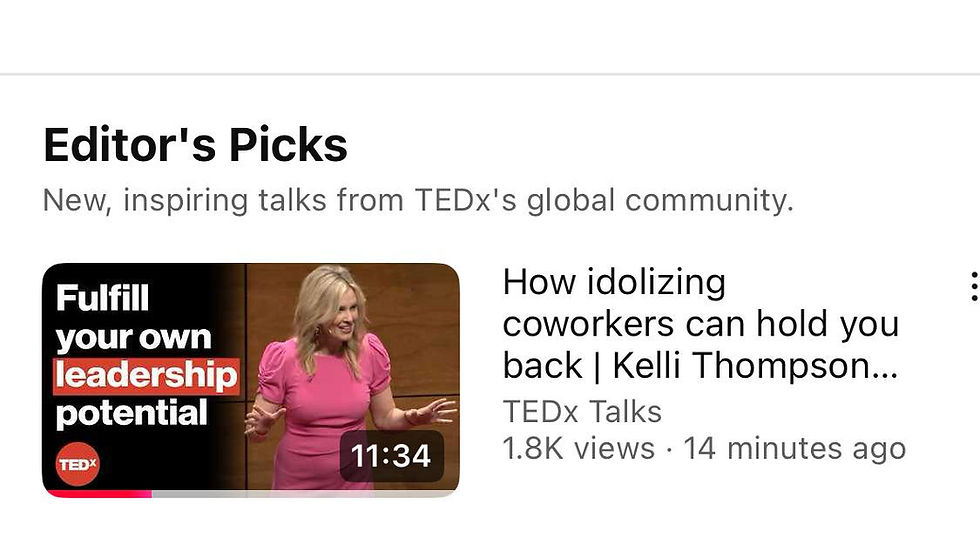How to design your next promotion
- Kelli Thompson

- Jun 9
- 4 min read
Updated: Aug 25
One of my clients works for an up and coming software platform in the financial services industry. After working for two name-brand technology firms you'd recognize, she loves the change of pace at a smaller, more flexible organization. Most of all though, she loves the people she works with and the mission of the company.
One of the challenges in a smaller organization (think 200 employees vs 20,000 employees) can be a career development “gray zone.” Many of my clients who work in small to medium size organizations can find themselves outgrowing their role and wondering “what's next?” because the career path may not be as crystalized or there are not as many open roles on the job posting board to choose from.
But here's a trap that many aspiring leaders can fall into no matter the size of your organization - they wait until a job is posted or someone leaves before they start thinking about their next move. By then, the opportunity has already taken shape, and it may not be shaped for you.
But the best career moves come from anticipating what’s around the corner and starting to show up like you belong there before anyone else sees it. This also builds your strategic thinking skills. It’s easy to get caught in the day-to-day of our roles and many leaders I coach are so focused on doing their job well that they forget to zoom out and ask:
What are the organization's growth or revenue goals?
What will those goals cause the company need one year from now?
What role could I play in making that future possible?
These are the questions employees don’t ask often enough, but they should so they can seize the opportunities that come with growth. We don't teach new to mid-level managers how to think strategically in corporate leadership development. However, developing this critical skill can not only help you uncover new opportunities for you to tackle in your next career steps, but it can also help you build your strategic-thinking muscles that will benefit your team and the organization you work for.
There are more tools below, but the conversation my client took back to her leader presented a forward-looking strategic snapshot of business needs from the seat she sits in along with a recommendation on how to get in front of some growth opportunities and challenges. Of course, she positioned herself as the right person to lead those challenges in a growing organization.
🔥 Remember, an organization can't reach $500M goals with $100M mindsets, habits, systems and processes. Are you waiting for your organization to slot you in a role or are you making and advocating a slot for yourself in your organization's growth trajectory?

PUT THIS IDEA INTO ACTION
How to Start Spotting Your Next Role
Here are some basic questions I ask my clients to help them name the future goals their team or organization has and then to begin to uncover the needs and opportunities that are required to achieve that growth:
1: Study the business goals
What’s changing in the company? Where is the growth coming from? What needs to scale and where are the cracks starting to show?
What are your organization's 2-5 year goals?
What new problems will the company face if it doubles its clients/revenue?
What kind of leader does this growth require? What skills or competencies must they have?
2: Zoom out from your function
What do other teams struggle with that you’re uniquely positioned to help solve?
What systems, tools, or skills will they need to achieve and sustain this growth that they don’t have today?
Where do silos, inefficiencies, or pain points affect the big picture?
3: Recommend (and maybe build…) before you’re asked
Don’t wait for a job posting to come, instead make recommendations on what roles need to be present to help your organization achieve its future state. Help paint the picture for your leaders about what problems, opportunities and scalabilities will be on the horizon as growth continues.
Start the project. Write the proposal. Build the framework. When leaders start to notice gaps, you’ll already have a solution in hand.
4: Have strategic conversations, not status updates
When you talk to your manager, shift the conversation from “what I’m working on” to “where the company is going and how I can help us get there.”
Reviewing these questions helps you think strategically about what's next and illustrates that maybe your next job isn’t on LinkedIn because it's in the problems your company hasn’t solved yet. You can grow your career by doing the job the company doesn’t even realize it needs yet.
Try this next: What will your company need when it’s twice the size it is today? What unique skills, talents and abilities can you use to bring it to life?

Kelli Thompson is an award-winning author, keynote speaker, and executive coach who specializes in helping high achievers advance to influential leaders in their organizations. She is the author of the critically acclaimed book, Closing The Confidence Gap: Boost Your Peace, Your Potential & Your Paycheck.
Learn more about: Executive Coaching | Speaking & Training | Group Programs






Comments